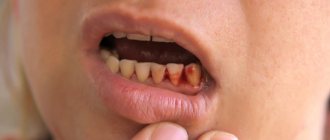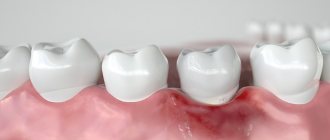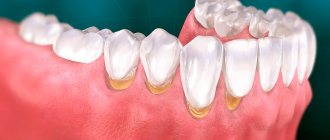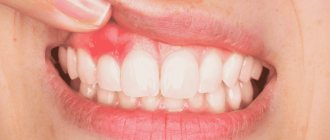Dental implantation is one of the best methods for restoring lost teeth and allows you to completely restore the anatomical and physiological features of the structure of the dentofacial apparatus. Despite the fact that dental implantation today is performed at a high quality level and is devoid of any disadvantages, sometimes patients still encounter some problems.
One of them is a change in the color of the gums near the dental implant. The Apex dental clinic uses dental implants from the world's leading manufacturers. They boast of their characteristics and allow you to achieve all your treatment goals.
The clinic’s experienced doctors do not make mistakes in their work, which guarantees impeccable quality of dental services with no negative consequences after the installation of dental implants.
And since doctors at the Apex dental clinic are often asked the question of why the gums near the dental implant turn black, today we will talk about exactly this, paying attention to ways to prevent the development of such a complication. Let's start, perhaps, by identifying the possible causes of darkening of the gums after installation of the implant.
Causes of gum darkening after implant installation
Successful implantation of dental implants is achieved at the Apex dental clinic in more than 90% of cases. Our patients almost never encounter the problem of subsequent darkening of the gums at the site of the installed dental implant, however, for many first-time visitors, this particular problem becomes the reason for seeking help.
Darkening of the gums after dental implant placement can have several causes. First of all, the quality of the selected implant is not high enough. In such situations, despite rapid healing, unpleasant symptoms (including darkening of the gums) may still occur.
Errors during dental implantation can also lead to the development of peri-implantitis. It is often caused by improper oral care after a successful operation.
Some chronic diseases, as well as bad habits, also increase the risk of developing peri-implantitis. Doctors at the Apex dental clinic always carefully analyze the condition of the patient’s teeth in order to issue correct recommendations for caring for a dental implant and inform about the possibility of unwanted symptoms.
Tartar
Tartar is a bacterial-mineral plaque that forms on the cervical surface of the enamel due to insufficient oral hygiene, as well as due to smoking and an incorrect diet.
First, a soft coating forms on the surface. It consists of bacteria and food debris. Soft plaque is easy to clean - it is removed even when chewing carrots, apples and other hard foods, as well as during oral hygiene using a toothbrush, floss or irrigator.
However, if a person does not remove the soft plaque, it can begin to petrify - change its structure, become hard and mineral. Turn into tartar. Hard plaque is much more difficult to remove - it often even resists cleaning with a classic brush.
Tartar is not only unsightly, it is also the cause of many diseases. For example, it can cause gingivitis and other gum inflammations. This occurs due to contact between bacteria and soft tissues of the oral cavity. But the most dangerous consequence of tartar is periodontitis, the inflammatory process of the periodontium, the tissues surrounding the roots and base of the tooth. It can lead to tooth mobility and loss.
Tartar treatment is quick and comfortable. Ultrasound, laser, or Air Flow technology can be used to break down mineral deposits. The dentist chooses a specific technique depending on the characteristics of the disease. Thus, thin dental plaque is cleaned using the Air Flow method - mineral deposits are removed by a water-air flow with the addition of active substances.
What to do if the gums near the implant have darkened
Answering this question, we immediately note that darkening of the gums near the implant and the occurrence of peri-implantitis are highly treatable and allow you to solve the problem in a short time.
Of course, as soon as you notice any changes in the area of the installed dental implant, you must immediately consult a doctor to determine the exact reasons for their development, make a diagnosis and carry out the necessary amount of treatment.
Already at the initial appointment, the doctor at the Apex dental clinic will conduct an objective examination and determine a further treatment plan. The specialist will tell you what you can do at home if the gums near the implant have darkened, and will also confirm whether the gums really turned blue after implantation - or in your case this is normal during the rehabilitation period.
A late visit to a specialist is fraught with the development of more serious complications, and therefore we strongly recommend not delaying your visit to the doctor.
Average cost of treatment in Moscow
Treatment of complications in dentistry
| Name of service | Cost, rub. |
| Consultations | |
| Dentist | 600 |
| Implantologist | 820 |
| Healing procedures | |
| Removing dental plaque in the area of 1 tooth | 180 |
| Periodontal applications in the area of 1 tooth | 370 |
| Laser therapy of the gum mucosa | 490 |
Treatment at home with medications and folk remedies
| Name of service | Cost, rub. |
| Medications | |
| Chlorhexidine | 16 |
| Rotokan | 38 |
| Metrogil Denta | 230 |
| Vinylin | 260 |
| Folk remedies | |
| Calamus root | 55 |
| Pharmaceutical chamomile | 60 |
| Thyme | 60 |
| St. John's wort | 60 |
| Melissa | 70 |
| Mint | 80 |
| Sage | 120 |
After implantation, the gums turned blue: other symptoms and diagnosis of peri-implantitis
Regardless of the reasons that caused peri-implantitis, this disease can be characterized not only by changes in the color of the gums, but also by other symptoms. These include bleeding gums in the area of the dental implant, deformation of the gums in this area, mobility of the crown, as well as painful or uncomfortable sensations in this localization.
Only a dentist can diagnose peri-implantitis when conducting an objective examination of the patient’s oral cavity. As a rule, this complication is characterized by all signs of inflammation and may involve swelling and redness, a local increase in temperature in the soft tissues of the oral cavity, etc.
When contacting the Apex dental clinic, already at the initial appointment, the doctor will accurately determine the cause of darkening of the gums after installation of the implant,, if necessary, prescribe additional instrumental research methods (radiography), and also select an individual treatment regimen.
By choosing the Apex dental clinic, you are making a choice in favor of high-quality dentistry and a quick solution to all dental problems that arise!
Other diseases that can cause darkening of gums
The appearance of dark spots disrupts the aesthetics of a smile and may indicate serious disorders in the body. Problems with the gums lead to bad breath and pain. This is dangerous due to sleep disturbances, decreased performance, and ignoring communication.
Darkening may be caused by:
- general diseases of the body;
- smoking;
- injury;
- hit by a foreign object;
- complications during treatment and tooth extraction;
- improper installation of dental crowns.
Dental treatment
Before implantation, sanitation of the oral cavity is indicated, which consists of identifying and treating pathological changes. Darkening may occur after dental treatment. When filling teeth, amalgam can be used - an alloy of mercury with one or more metals. This filling material is used for chewing teeth in patients of any age, regardless of the severity of caries.
The disadvantage of amalgam is a reaction to contact of the material with the oral mucosa. It is expressed in the appearance of dark spots on the gums. Spots may appear immediately after treatment or after some time. Such manifestations are not considered a pathology. To improve aesthetics, stains are removed surgically.
General diseases of the body
Darkening may be due to the presence of common diseases. Peutz-Jeghers syndrome is characterized by the presence of dark spots on the skin and mucous membranes. This hereditary disease is diagnosed in early childhood. It occurs as a result of a gene mutation and is accompanied by the growth of hamartomatous polyps in the gastrointestinal tract. Therefore, another name for the disease is hamartomatous polyposis.
Darkening and the formation of dark spots on them do not appear immediately. These symptoms develop with age. External signs of the disease are not dangerous. However, their cause poses a serious threat to the health and life of the patient. Polyps provoke the development of cancer of internal organs. No effective comprehensive treatment for the syndrome has been developed.
Regular examination allows you to monitor the development of the disease. If polyps reach critical sizes, they are removed. Medicines that prevent the appearance of tumors are also prescribed.
Changes in gum color may be a symptom of Addison's disease . This is an endocrine disease with disruption of the adrenal glands, which are unable to produce hormones in the required quantities.
If the disease is present, the dark spots have an irregular shape and may form stripes. Their presence is due to changes in the balance of hormones, provoking melanin deposits. Associated signs of the disease are loss of appetite, general malaise, fatigue, and bronze skin tone.
Black gums and teeth due to smoking
The color change may be due to smoking, because nicotine causes changes in the body that are very difficult to reverse. Smoker's melanosis is characterized by discoloration of the oral mucosa, discoloration of teeth, and an unpleasant odor.
Any diseases of the mucous membrane caused by smoking, under unfavorable conditions, can subsequently become malignant. Therefore, in order to get rid of pigmentation, you should get rid of the main cause, i.e. stop smoking. Afterwards, the spots are removed using laser correction.
- Complete restoration of the dentition in just 4 days!
more detailsRoott Pterygoid Implants Sinus lift is no longer needed!
more details
Once and for life! Express implantation in 4 days with a permanent ReSmile prosthesis
more details
All-on-4, All-on-6, ReSmile, Zygomatic implantation We use all modern methods of dentition restoration
more details
How to care for your gums after implantation
After dental implantation, it is recommended to completely abstain from eating and drinking for two hours. Next, for 2-3 weeks, nutrition should be gentle, without consuming solid, excessively hot or cold foods.
One of the most important rules is to regularly rinse your mouth with prescribed antiseptic solutions, chamomile or other ingredients recommended by your doctor.
It is preferable to chew on the side opposite the suture, however, this recommendation will be individual for each patient. During the first 24 hours after the installation of dental implants, it is not recommended to brush your teeth, but in more detail about how to care for your gums after implantation, the doctors of the Apex dental clinic will tell you at your consultation.
How to treat tooth darkening
It is not always possible to correct darkening of the enamel. This is easiest to do when the cause is poor oral hygiene or smoking.
All that is needed in this case is professional cleaning.
There are also several other means:
- Treatment of caries. In this case, all work is standard - the dentist removes the damaged tissue, then fills the area.
- Silvering. Performed for fluorosis. In some cases, it helps to make the enamel lighter.
- Veneer installation. This method is more of a camouflage method than a therapeutic one. It is important to understand that sometimes the enamel remains in an altered state. In this case, all that remains is to install an overlay made of composite material or ceramics on it.
The final decision is made by the doctor after examination and medical history. The patient also bears a serious responsibility during treatment.
Sometimes it is necessary to change the diet, in other cases it is necessary to change the medications taken or improve oral hygiene.
Causes of tooth discoloration
Filling during the treatment of carious lesions, pulpitis or periodontitis is not always able to protect against the penetration of pathogenic bacteria or injury. This is most often due to medical errors during treatment, non-compliance with the rules of oral hygiene, injury to the jaw or an individual tooth.
Common causes of pathology:
- Penetration of pathogens under the filling and repeated carious lesions. Caused by shrinkage and aging of the filling, non-compliance with installation technology, and low-quality materials.
- Carious lesion of another part of the tooth.
- Development of the inflammatory process in the cavity and pulp necrosis.
- Incomplete pulp extraction, poor root canal sealing.
- Translucent metal pins and inlays.
- Disorders of calcium absorption and metabolism.
- Development of fluorosis.
- Traumatic injury.
- Taking Chlorhexedine or tetracycline antibiotics.
Several factors can influence the appearance of a dark shade of a tooth under a filling.











